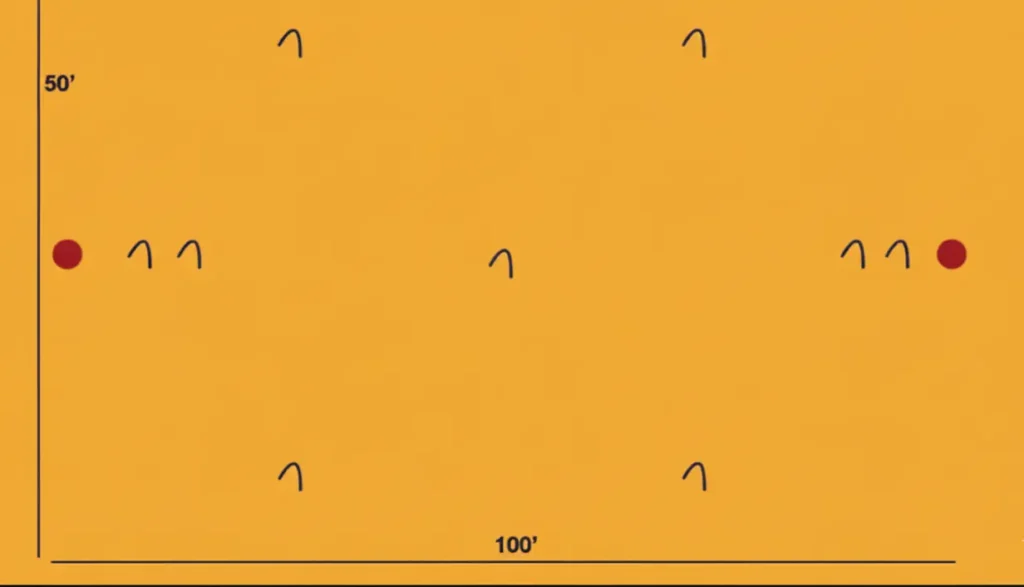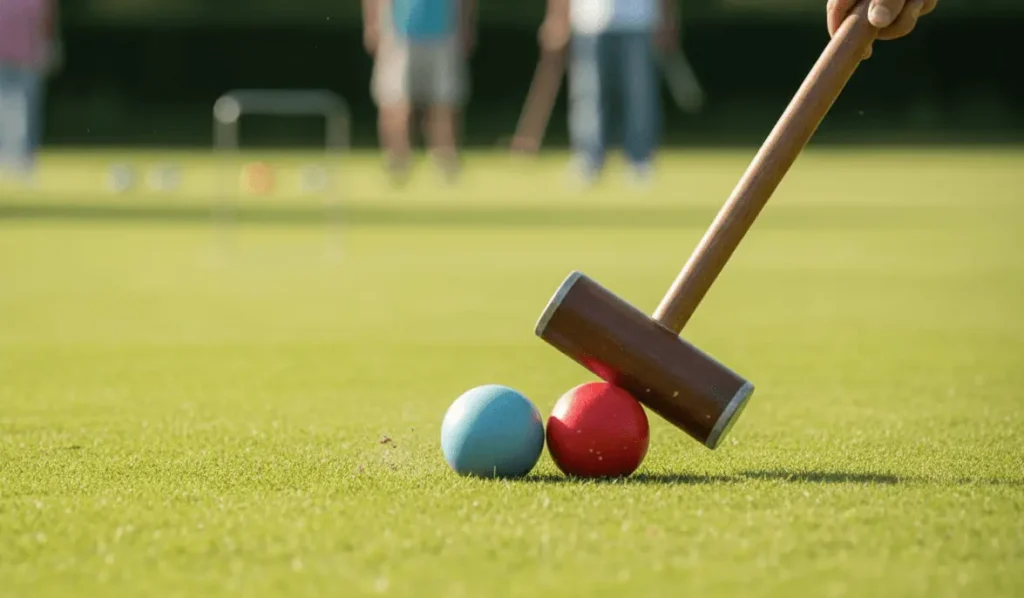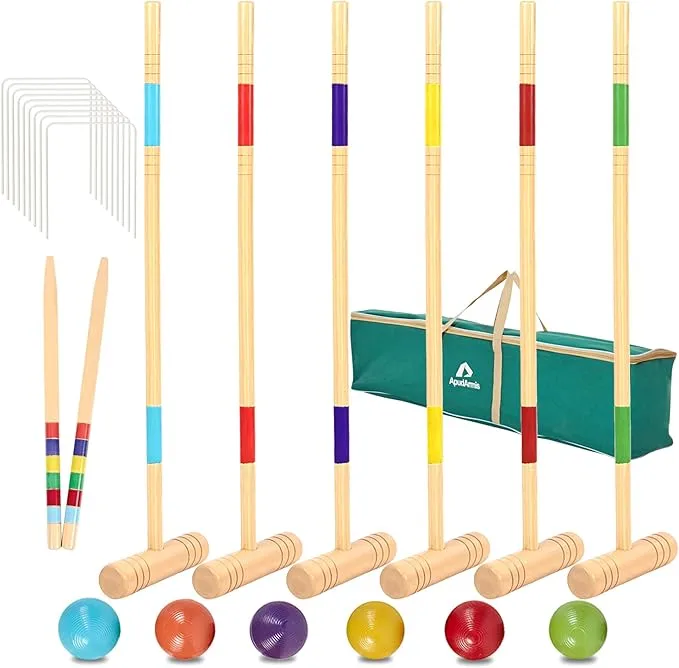Croquet Rules | How to Play Croquet
You hit colored balls through metal wickets using a wooden mallet. Simple premise. Surprising depth.
Croquet brings elegance to lawn games. Players dress up. The pace is civilized. Strategy matters more than athleticism.
This classic game has entertained people for centuries. From backyard parties to international tournaments, croquet adapts to all skill levels.
Let me show you how to play.
What You Need for Croquet
A complete croquet set includes specific equipment.
You need four colored balls. Standard colors are blue, red, black, and yellow. Each ball weighs about 16 ounces and measures roughly 3.5 inches in diameter.
You need four mallets. Each mallet has a long wooden handle and a heavy head. Mallet heads weigh between 2.5 and 3.5 pounds. Handle length ranges from 32 to 38 inches.
You need six or nine wickets depending on which version you play. Wickets are metal hoops stuck into the ground. Each wicket measures about 12 inches wide and stands 12 inches tall above ground.
You need one or two stakes. Stakes are vertical posts that mark starting and finishing points. Most stakes display the playing order colors painted on them.
You can set up a full game with this croquet set. It includes the mallets, balls, and wickets you need.
Understanding the Two Main Croquet Versions
Croquet comes in two popular formats.
Six Wicket Croquet
Six wicket croquet is the traditional English garden version. It uses six wickets arranged in a rectangular pattern with one stake in the center. This version is standard for tournament play worldwide.
Nine Wicket Croquet
Nine wicket croquet is the American backyard version. It uses nine wickets in a double diamond pattern with two stakes at opposite ends. This format is most common in North America.
Both versions follow similar core rules. The main differences are court layout and winning conditions.
This guide covers nine wicket croquet since it’s most popular for casual play. Six wicket rules are similar but with adjusted patterns.
Setting Up a Nine Wicket Croquet Court
The standard nine wicket court measures 100 feet long by 50 feet wide.
You can scale down for smaller yards. A 50 by 25 foot court works fine for casual games. Keep the proportions roughly the same.
Stake placement: Place one stake at each end of the court, centered widthwise and 6 feet from the end boundary.
Wicket arrangement: Set up wickets in a double diamond pattern. Start at one stake, place two wickets forming the first diamond. Continue to create a second diamond leading to the far stake. Add a center wicket between the diamonds.
Number the wickets in playing order. Wickets 1 and 2 form the first diamond near the starting stake. Wickets 3 through 6 create the middle section. Wickets 7 and 8 form the second diamond. Wicket 9 sits between wickets 3 and 6.
Space wickets evenly to create balanced diamonds. On a full size court, wickets sit about 16 feet apart. Adjust proportionally for smaller courts.
Plant wickets firmly in the ground. Push them straight down until stable. Make sure the opening faces the proper direction for ball passage.

How Many Players Can Play Croquet
Croquet accommodates two to six players.
Two players: Each player uses two balls. One player controls blue and black. The other controls red and yellow. This creates the most strategic game.
Four players: Play as teams of two. Each player uses one ball. Partners work together to advance both their balls and block opponents.
Six players: Play with additional ball colors, typically green and orange. Each player controls one ball. This makes a longer, more social game.
Teams are divided into sides. One side has blue and black balls. The other side has red and yellow balls. Always.
The Basic Object of Croquet
You advance your balls around the court by hitting them with your mallet.
Your balls must pass through each wicket in the correct order and direction. After completing all wickets, hit the finishing stake.
The first player or team to get both their balls through all wickets and hit the stake wins.
You score one point for each wicket your ball passes through in proper sequence. You score one point for hitting each stake. Maximum points per ball is 16 in nine wicket croquet.
Croquet Turn Order and Starting Play
Play follows strict color order throughout the game.
Playing order: Blue, red, black, yellow. This order never changes. If using six balls, add green after yellow, then orange.
The starting stake displays these colors from top to bottom showing the sequence.
All balls start from a position three feet from wicket number one. Place your ball here when it’s your turn to start.
The blue player goes first, hitting their ball from the starting position toward wicket one. Then red goes. Then black. Then yellow. The cycle repeats.
How to Take Your Turn in Croquet
Your turn begins with one stroke. Hit your ball with the mallet toward your next wicket.
After your stroke, your turn ends unless you earn bonus strokes.
You earn bonus strokes two ways:
Scoring a wicket or stake: Hit your ball through your next wicket in order or hit a stake. Earn one bonus stroke.
Roqueting another ball: Hit your ball so it strikes another ball. Earn two bonus strokes. This is called a roquet.
The key to croquet is chaining together bonus strokes. Good players keep their turn going through multiple wickets and roquets.
What is a Roquet in Croquet

A roquet happens when your ball hits another ball during your stroke.
After roqueting a ball, you get two bonus strokes. The first bonus stroke has four options for how to take it:
Option 1: Hit your ball from where it stopped after the roquet.
Option 2: Place your ball one mallet head distance or less from the ball you hit. Take your shot from there.
Option 3: Place your ball touching the roqueted ball without using your foot. Hit your ball. This is a croquet shot.
Option 4: Place your ball touching the roqueted ball. Put your foot on your ball to hold it steady. Strike your ball to send the other ball away while yours stays put. This is a foot shot.
After taking the first bonus stroke using any of these options, take your second bonus stroke as a normal shot from where your ball rests.
Understanding Deadness Rules
In basic backyard croquet, you can only roquet each ball once per turn.
After you roquet red, you are “dead” on red for the rest of your turn. You cannot roquet red again to earn bonus strokes.
You can still hit dead balls. But hitting them does nothing. Your ball just bounces off and no bonus strokes are earned.
Clearing your deadness happens in two ways:
Score your next wicket: When your ball passes through the next wicket in order, you clear all deadness. You’re alive on all balls again.
End of turn: When your turn ends, all deadness clears automatically at the start of your next turn.
Advanced players use a deadness system where deadness carries between turns. Basic backyard rules clear deadness each turn for simplicity.
If you enjoy backyard games, check out my guide on how to play cornhole, bocce ball, and ladder ball.
How to Score Wickets in Croquet
Your ball must pass completely through the wicket in the correct direction.
The ball starts on one side of the wicket. It must emerge on the other side. If any part of the ball remains between the uprights when it stops, you haven’t scored the wicket yet.
You can take multiple strokes to get through a wicket. Approach it with one shot. Push through on another turn. This counts when the ball finally clears.
Wickets must be scored in numerical order. You cannot skip ahead. Blue starts at wicket one. After scoring one, blue attempts wicket two. Then three. And so on.
Some wickets are played twice. In the double diamond pattern, you play certain wickets going out and play them again coming back. The stake and court layout show you which direction to play each time.
The Croquet Shot Technique

The croquet shot is your most powerful tool.
Place your ball touching the roqueted ball. Put your foot firmly on your ball. Strike your ball with the mallet.
Done correctly, your ball stays put or moves slightly. The roqueted ball shoots away in the direction you aimed.
This lets you knock opponent balls far away while positioning yours perfectly for the next wicket.
Beginners struggle with croquet shots. Keep your foot firmly planted. Strike through the ball. Don’t lift up during the swing.
Practice makes this shot easier. Master it and your game improves dramatically.
Rover Balls and Staking Out
After scoring all wickets, your ball becomes a rover.
Rover balls have special status. They can roquet any ball and earn bonus strokes. They can move freely around the court.
But rovers cannot score additional wickets. Their only remaining goal is hitting the finishing stake.
When a rover hits the stake, it stakes out and leaves the game permanently. That ball has scored maximum points and finished.
Any ball can stake out a rover. If an opponent hits your rover ball into the finishing stake, your rover leaves the game even if you didn’t want it to.
Once both balls from one side stake out, that side wins.
Common Croquet Faults
Certain actions violate the rules and end your turn.
When a fault occurs, your turn ends immediately. Balls are replaced to their positions before the fault. No points scored.
Out of Bounds Rules
Balls that leave the court boundaries are brought back in.
Place out of bounds balls one mallet length inside the boundary at the point they went out.
There is no penalty for going out of bounds. Your turn continues if you had bonus strokes remaining.
The imaginary yard line runs one mallet length inside all boundaries. This is where out of bounds balls return.
Croquet Court Dimensions
Understanding standard measurements helps with setup.
These are standard sizes. Backyard games often use whatever space available. Scale proportionally.
Croquet Strategy and Tips

Good croquet players use specific tactics.
Control the game through roquets. Each roquet gives you two bonus strokes. Chain multiple roquets together to advance several wickets in one turn.
Position balls strategically. Leave your balls near your next wicket. Make it easy to score next turn.
Block opponents. Position your balls in front of their wickets. Force them to roquet you, giving you control.
Use your partner ball. In two ball games, position your first ball to help your second ball. Roquet it for bonus strokes.
Send opponents away. Use croquet shots to knock opponent balls far from their next wicket. This costs them several turns recovering.
Plan multiple shots ahead. Think about where each shot leaves you for the next shot. Don’t just aim for the immediate wicket.
Protect rovers. Keep your rover balls away from the finishing stake until ready. Don’t let opponents stake you out early.
Variations and House Rules
Different groups play with different optional rules.
Time limits: Play for 60 minutes. Highest score when time expires wins. This ensures games finish.
Simplified deadness: Skip the deadness rule entirely. Allow roqueting the same ball multiple times per turn. Makes games easier for beginners.
Wicket points only: First to 7 wicket points wins instead of completing the full course. Shorter games.
Poison ball: After staking out, a rover becomes poison. If poison hits another ball, that ball is eliminated from the game. Adds drama.
Tournament rules: Use strict timing, deadness rules, and fault penalties. Matches competitive play standards.
Agree on which rules you’re using before the first stroke. Write them down if playing with new people.
Croquet Etiquette
- Good croquet includes proper conduct.
- Stand still and quiet when others are shooting. Don’t walk around or make noise.
- Congratulate good shots even from opponents. Croquet is a gentleman’s game.
- Help measure close calls fairly. Don’t argue over inches.
- Keep the pace moving. Take your shot within 45 seconds. Long delays frustrate other players.
- Repair divots and damaged turf. Keep the court playable for everyone.
- Know when your turn is coming. Be ready when called.
- Accept referee decisions gracefully. Arguing ruins the spirit of the game.
Building a Croquet Court
- You can create a permanent croquet court with some effort.
- Choose a level area. Survey the ground carefully. Even slight slopes affect ball roll dramatically.
- Remove rocks, sticks, and debris. Fill low spots. Level high spots.
- Plant grass or maintain existing lawn. Mow to half inch height. Short grass plays best.
- Mark boundaries with stakes or paint. This prevents disputes.
- Install wickets firmly. Push them several inches deep. Test stability.
- Add the finishing stakes at each end.
- Professional courts use specialized grass and drainage. Backyard courts just need reasonably flat, mowed grass.
- Total cost ranges from zero (existing lawn) to several thousand (professional installation).
Six Wicket Croquet Differences
The six wicket version has a simpler layout.
Wickets form a rectangle with one stake in the center. Play up one side, across the top, down the other side, and back.
The first six hoops are played once. Then play them in reverse order for 12 total hoop points.
First side to score all 12 hoop points plus 2 peg points for both balls wins. Total is 26 points per side.
Rules for roquets, deadness, and bonus strokes are identical to nine wicket. Only the court layout and point total differ.
Six wicket croquet is standard for serious competitive play worldwide.
Frequently Asked Questions (FAQs) about Croquet Rules
Start Playing Croquet Today
Croquet combines strategy, skill, and social interaction. The rules make sense after one game. Mastering tactics takes seasons.
Set up your wickets. Choose your colors. Grab your mallets. Take the first shot toward wicket one.
Your croquet game is ready to begin.

